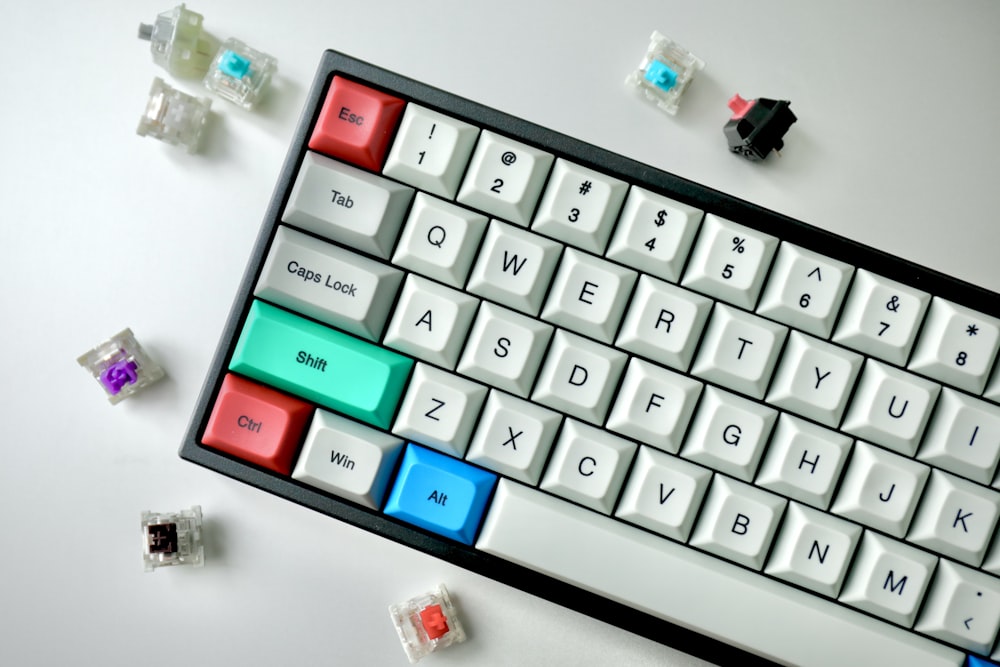Within every MX-style switch is a spring that pushes the stem back up after you have pressed down. Different spring lengths, weights, and coils can change the feeling of the press, the heaviness, and how fast it takes for a switch to rebound. Tactile switches in particular require a certain heaviness of spring for it to be able to rebound up past the tactile hump. This is unlike a linear switch which goes smoothly down and has no need for a minimum spring weight. Springs also differ between manufacturers in terms of how the springs are coiled and the typical length of the springs found in their respective switches. There are also certain brands that sell aftermarket springs separate from switches. These brands include TX springs, Sprit springs, Thic Thock springs, and Geon springs, to name a few.
Now we will discuss the types of springs one can buy from keyboard vendors and the various use-cases for each.
Linear
Many older and more mass-produced switches, such as the Cherry MX Red switches, will have linear switches of standard sizing. For a linear switch, this will mean that the force it takes to press down will be the same all the way down, and will rebound at a linear speed as well. However, different switch manufacturers will produce and use different springs that they may call “linear”. For a tactile switch, it is more imperative to choose a heavier spring to ensure that the tactility can be overcome by the switch.
XL Linear
Moreso found in heavy tactiles, a XL linear spring is one that tends to be much longer than your average linear spring. This means that, before you even press down, there is more compression on the spring to begin with. This can result in a heavier feel to a normal length spring of the same weight, and also a faster rebound due to more compression. The WS Heavy Tactile, for example, utilizes a XL linear spring because of how thick the tactile bump is.
Progressive
Some switches manufacturers, like KTT switches, tend to utilize progressive springs moreso than other more mainstream switch manufacturers such as Cherry and Gateron. Progressive springs can be an acquired taste, as some progressive springs by certain spring-makers such as Thic Thock’s Magically Progressive (MP) springs, have a noticeable feel difference from linears. The force it takes to press down on a progressive spring exponentially increases as you press down, so that the bottom-out weight can be much heavier than the actuation weight. This spring can be utilized when you want to soften a bottom out sound of a switch. In some instances, it can result in a slightly deeper sounding switch, and can feel like typing on a marshmallow.
Complex
Although similar to the progressive spring, complex springs slightly differ in that the initial press is exponentially higher than the rest of the press down, which is mostly linear in feel. This can reduce accidental presses but does not slow or soften the bottom-out feel of a switch.
Multi-stage/Double-stage
Characterized by a thick coil in the middle of the spring separating two distinct parts of the spring, double-stage springs have a fast rebound and slightly heavier but snappy press to them on the way down. These can increase the loudness of the sound of the switch hitting the top housing and can make a switch feel less sluggish and more responsive.
Sprit Slow
Although the coils are similar to that of a regular XL linear spring, “slow” springs are distinct to the Sprit brand of springs. According to the graphs provided by Sprit, slow springs are meant to increase the initial force it takes to press down without raising the actual bottom-out weight. Their use-case is purely for those of hobbyists that wish to fine-tune the feel of their switches, as these do not occur in any stock switch to that of my knowledge.
Gazzew Springs
Gazzew’s springs are quite similar to linear springs in their coiling. However, according to the product page on the Ringerkeys website, the Gazzew springs that weigh at 55g, 65, and 72 have “[m]ulti zone, universal polarity springs”. The increased coils on both ends are reminiscent of progressive springs, but there are no claims via Gazzew on how differently the feel is to progressive springs.
All aftermarket springs come unlubed, so it is imperative to lube them for the best feel. The most popular method is “bag lubing”, usually with Krytox 105 grade oil, or perhaps a slightly thicker oil such as 106 or 107. These oils come in little droppers, and in my experience, I tend to do 1 drop per 10 switches.
I hope this article was informative and helpful in understand which springs will best suit your needs and your switches. Feel free to check out my article on keyboard modding linked below if you plan to do other modifications to your keyboard.









